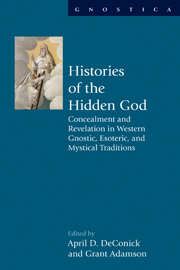 Histories of the Hidden God
Histories of the Hidden God Book contents
- Frontmatter
- Contents
- Acknowledgments
- Contributors
- Introduction: In search of the hidden God
- Part I Concealment of the Hidden God
- 1 Who is hiding in the Gospel of John? Reconceptualizing Johannine theology and the roots of Gnosticism
- 2 Adoil outside the cosmos: God before and after Creation in the Enochic tradition
- 3 The old gods of Egypt in lost Hermetica and early Sethianism
- 4 Hidden God and hidden self: The emergence of apophatic anthropology in Christian mysticism
- 5 God's occulted body: On the hiddenness of Christ in Alan of Lille's Anticlaudianus
- Part II The Human Quest for the Hidden God
- Part III Revelations of the Hidden God
- Afterword: Mysticism, Gnosticism, and esotericism as entangled discourses
- Bibliography
- Index
5 - God's occulted body: On the hiddenness of Christ in Alan of Lille's Anticlaudianus
from Part I - Concealment of the Hidden God
- Frontmatter
- Contents
- Acknowledgments
- Contributors
- Introduction: In search of the hidden God
- Part I Concealment of the Hidden God
- 1 Who is hiding in the Gospel of John? Reconceptualizing Johannine theology and the roots of Gnosticism
- 2 Adoil outside the cosmos: God before and after Creation in the Enochic tradition
- 3 The old gods of Egypt in lost Hermetica and early Sethianism
- 4 Hidden God and hidden self: The emergence of apophatic anthropology in Christian mysticism
- 5 God's occulted body: On the hiddenness of Christ in Alan of Lille's Anticlaudianus
- Part II The Human Quest for the Hidden God
- Part III Revelations of the Hidden God
- Afterword: Mysticism, Gnosticism, and esotericism as entangled discourses
- Bibliography
- Index
Summary
While God is always a more or less hidden presence in monotheistic traditions, nevertheless in a Christian context it is fundamental that the incarnation of Christ mediates this hiddenness. Both figuring and operating God's intent for humanity, Christ is God made visible. The body of Christ is memorialized in the Eucharist and the events of his human life structure the main feast days of the Church – events that help to keep God present in the lives of practicing Christians, despite the ongoing hiddenness of God's true nature (understood as a product of the embodied human separation from the divine).
It thus creates a particularly interesting enigma when, in a work designed to shadow the Christian dispensation, it is Christ himself that goes missing. My analysis here will concern the manner in which God's body is hidden in just such a work: a twelfth-century Latin cosmological fable, the Anticlaudianus of Alan of Lille, alternately titled The Good and Perfect Man. Written in the 1180s, the Anticlaudianus in some respects seems to be a repositioning of an ethical system, suitable for the fallen world, on top of the Neoplatonic cosmology which everywhere imbues Alan's writing. The story of the Anticlaudianus is clearly redemptive. Yet the idea of redemption is complicated by the fact that, although the action clearly takes place after Christ's incarnation, the agent of redemption does not appear to be Christ himself (who is mentioned only in passing), but instead another man, a New Man, whose creation is a project instigated by Nature.
- Type
- Chapter
- Information
- Histories of the Hidden GodConcealment and Revelation in Western Gnostic, Esoteric, and Mystical Traditions, pp. 101 - 119Publisher: Acumen PublishingPrint publication year: 2013


